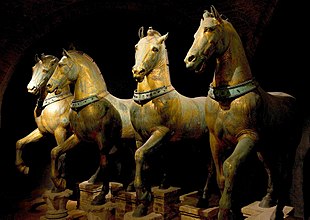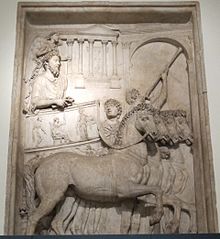
Back عربة رباعية الخيول Arabic Cuadriga AST Квадрыга Byelorussian Квадрига Bulgarian Pevar-yev Breton Quadriga Catalan Sztërëkòniowi zaprzig CSB Quadriga (firspand) Danish Quadriga German Kvadrigo Esperanto

A quadriga is a car or chariot drawn by four horses abreast and favoured for chariot racing in classical antiquity and the Roman Empire. The word derives from the Latin quadrigae, a contraction of quadriiugae, from quadri-: four, and iugum: yoke. In Latin the word quadrigae is almost always used in the plural[1] and usually refers to the team of four horses rather than the chariot they pull.[2] In Greek, a four-horse chariot was known as τέθριππον téthrippon.[3]
The four-horse abreast arrangement in a quadriga is distinct from the more common four-in-hand array of two horses in the front plus two horses behind those.
Quadrigae were raced in the Ancient Olympic Games and other contests. They are represented in profile pulling the chariot of gods and heroes on Greek vases and in bas-relief. During the festival of the Halieia, the ancient Rhodians would sacrifice a quadriga-chariot by throwing it into the sea.[4] The quadriga was adopted in ancient Roman chariot racing.
Quadrigas were emblems of triumph; Victory or Fame often are depicted as the triumphant woman driving it. In classical mythology, the quadriga is the chariot of the gods; the god of the Sun Helios (often identified with Apollo, the god of light) was depicted driving his quadriga across the heavens, delivering daylight and dispersing the night.[5]

- ^ According to Aulus Gellius 19.8, Julius Caesar considered it incorrect to use the word in the singular.
- ^ Lewis and Short Latin Dictionary, s.v. quadrigae.
- ^ Liddell, Scott, Jones Greek Lexicon, s.v. τέθριππος.
- ^ Farnell, Lewis, The Cults of the Greek States Vol. ΙV, Cambridge University Press, 2010, ISBN 978-1-108-01546-2, p. 20, note b.
- ^ Smith, s.v. Helios
© MMXXIII Rich X Search. We shall prevail. All rights reserved. Rich X Search